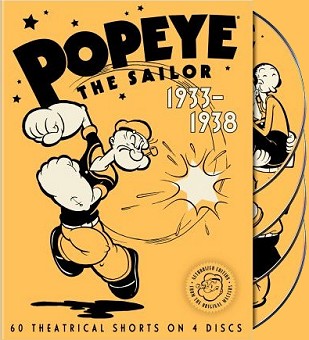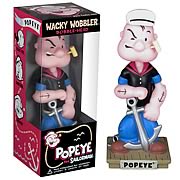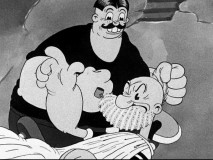 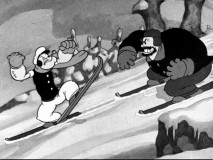 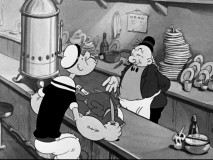
Disc 3
A Clean Shaven Man (1936) (6:05)
After hearing Olive sing of her preference for a clean shaven man, Popeye and Bluto both head to Wimpy's Barber Shop. Since he's out, they agree to shave one another, or at least that's the plan.
Brotherly Love (1936) (6:24)
Inspired by Olive's song about brotherly love on the radio, Popeye helps out those he encounters with acts of generosity. One crowd of street fighters, however, needs the values beaten into them.
I-Ski Love-Ski You-Ski (1936) (6:14)
Bluto follows one step behind Popeye and Olive to wreak havoc on their snowy mountain climb.
Bridge Ahoy! (1936) (6:48)
Objecting to Bluto's ferry fares, Pluto, Olive, and Wimpy team up to build a toll-free bridge.
What -- No Spinach? (1936) (6:27)
Unable to sneak in a hamburger while working at Bluto's restaurant, Wimpy tries to sample Popeye's roast duck order. When Popeye won't pay, Bluto puts up a fight.
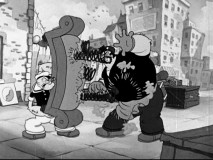 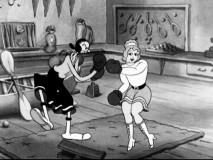 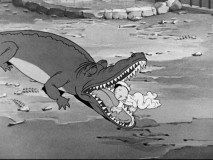
I Wanna Be a Life Guard (1936) (6:27)
In vying for the same lifeguard position, Popeye and Bluto showcase their respective swimming pool talents, before bringing their usual fisticuffs underwater.
Let's Get Movin' (1936) (6:07)
Popeye offers to help Olive move out of her apartment, then the hired mover shows up. It's Bluto, of course, and it's little surprise that he and Popeye turn the project into a strength competition.
Never Kick a Woman (1936) (6:30)
Popeye wants to teach Olive Oyl some self-defense lessons, but the presence of another woman raises Olive's temper, until the two women put on boxing gloves and fight.
Little Swee'Pea (1936) (7:06)
Popeye takes Swee'Pea to the zoo, where the tot crawls into the cages and gets dangerously close to an elephant, a crocodile, and a hippopotamus. It's Popeye, however, who ends up getting hurt.
Hold the Wire (1936) (6:17)
While Popeye is proving his romantic side with some poetry recitals over the phone to Olive, Bluto crosses the wires and offers some less flattering rhymes.
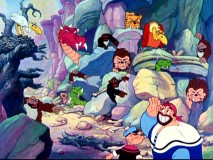 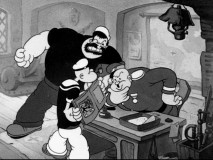 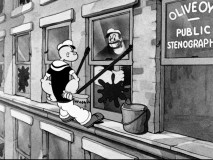
The Spinach Roadster (1936) (6:18)
In the hopes that Olive will accompany him in his superior automobile, Bluto plots to derail Popeye's little car.
Popeye the Sailor Meets Sindbad the Sailor (1936) (16:30)
In Popeye's first two-reel and Technicolor adventure, proud sailor Sindbad (Bluto), who has a wide array of imposing creatures at his disposal, spots a ship with Popeye, Olive, and Wimpy near his isle. He seizes the lady and expects his beasts to take care of Popeye, but the shorter sailor has more than enough fight in him.
I'm in the Army Now (1936) (6:12)
Popeye and Bluto are both after the final spot in the army. To prove they're right for the part, they each try to impress the enrolling officer... with clips from some of their previous cartoons.
The Paneless Window Washer (1937) (6:08)
Window washing becomes the latest field at which Popeye and Bluto compete. High above the ground, the two duel for the right to clean stenographer Olive Oyl's office windows.
Organ Grinder's Swing (1937) (6:22)
Bluto objects to the music-making presence of Wimpy and his monkey, leading Popeye to fight at length on his pal's behalf.
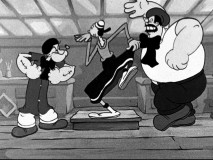 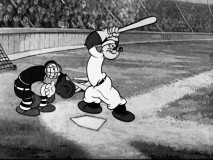 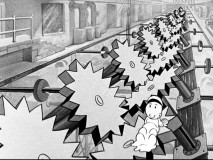
Disc 4
My Artistical Temperature (1937) (6:03)
Rivalry runs high in the shared studio of sculptor Popeye and painter Bluto, as the two artists fight over model Olive Oyl's stance.
Hospitaliky (1937) (6:06)
To elicit the attention of hospital nurse Olive, both Popeye and Bluto seek out ways to get hurt.
The Twisker Pitcher (1937) (6:57)
A baseball game pits Popeye's Pirates against Bluto's Bears, with the latter taking a big lead thanks to their star's tampering with Popeye's spinach can.
Morning, Noon and Night Club (1937) (7:50)
After vandalizing billboards for it, Bluto seeks to disrupt Olive and Popeye's dancing act at Wimpy's Cafe.
Lost and Foundry (1937) (6:42)
During Popeye and Olive's lunch date, Swee'Pea wanders into Popeye's factory. Peril threatens all, leastly the toddler who calmly weaves in and out of machinery.
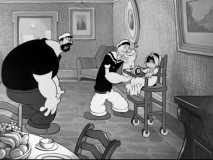 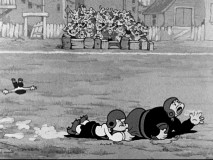 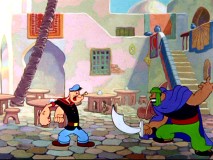
I Never Changes My Altitude (1937) (6:03)
Olive runs off with aviator Bluto, but when he doesn't treat her right, less-experienced pilot Popeye vows to save her and knock some sense into his counterpart while airborne.
I Like Babies and Infinks (1937) (7:01)
Getting Swee'Pea to stop crying and start laughing becomes the latest activity at which Popeye and Bluto try to outdo each other.
The Football Toucher Downer (1937) (6:25)
Popeye recalls a childhood football game in which he single-handedly turned the tables on Bluto's team
Protek the Weakerist (1937) (7:38)
Popeye is embarrassed to walk Olive's freshly-groomed little dog.
Popeye the Sailor Meets Ali Baba's Forty Thieves (1937) (17:13)
Popeye's second color short finds him summoned to the desert to stop Abu Hassan (a tanned Bluto) and his legendary gang of bandits, who disarm the sailor and capture Wimpy and Olive.
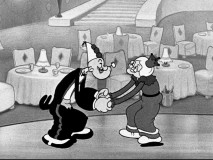 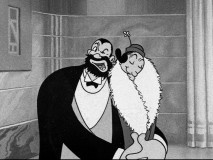 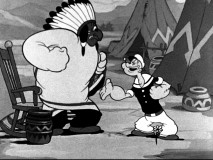
Fowl Play (1937) (7:06)
Popeye sends a parrot to serenade Olive, but upon seeing the bird, Bluto quickly develops an intent to kill it.
Let's Celebrake (1938) (7:21)
In high spirits on New Year's Eve, Popeye insists that Olive's grandmother join the gang for a fun night out. To thunderous applause, the sailor and the old lady cut the rug on the dance floor.
Learn Polikeness (1938) (7:00)
Olive brings Popeye to Professor Bluteau for etiquette training.
With the sailor predictably but hilariously struggling, the professor tries to move in on Olive.
The House Builder Upper (1938) (6:03)
After Olive's house burns down, Popeye goes beyond the volunteer fireman's call of duty and builds her a new one, with some "help" from Wimpy.
Big Chief Ugh-Amugh-Ugh (1938) (7:25)
Olive falls into Big Chief Ugh-Amugh-Ugh's open squaw position. When Popeye tries to rescue her, he's forced to prove his worth to the Indian chief.
A Note on Content: Anyone familiar with DVD sets of vintage cartoons has come to expect some kind of politically correct gesture to contextualize their productions and distance current distributors from the few presently unacceptable depictions they contain. Gladly, there are no unskippable introductions from critic/animation buff Leonard Maltin (who does appear elsewhere, with a Popeye lapel pin and his usual big smile) or the far worse cuts for content. All Warner provides are two disclaimers. One on the back of the package tinily announces that the DVD is "intended for the adult collector and may not be suitable for children." The other, a briefly-glimpsed, kudos-earning paragraph at the start of each disc, announces that "...these animated shorts are being presented as they were originally created, because to do otherwise would be the same as claiming these prejudices never existed."
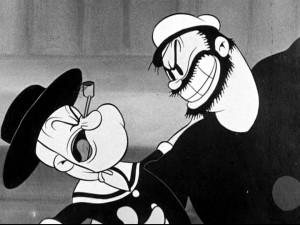 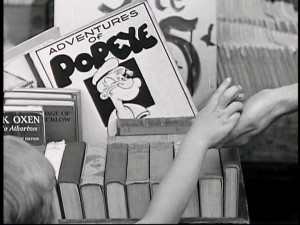
VIDEO and AUDIO
Those who have long been wishing and hoping that a licensed Popeye collection
would come to DVD and put an end to all of the picture problems that mar public domain releases may be a little disappointed by what they find here. Far from perfect, the video quality is pretty erratic, jumpy, grainy, and marked by frequent scratches and plenty of other small intrusions. Of course, age must be taken into consideration, and these 69-74-year-old cartoons can't be expected to look the same as, say, 2004's computer-animated Popeye's Voyage: The Quest for Pappy. I have little doubt that the picture quality here blows away the lesser efforts of tiny independent studios; judging from customer reviews online, the improvement offered seems to be quite the revelation.
Still, I must admit there's a bit of room for improvement, having seen how wonderful digitally-restored Mickey Mouse and Silly Symphony cartoons from the same era have looked on DVD. That said, age is just one factor to consider; preservation methods may have rendered these shorts in greater state of disrepair. That's easy to imagine when one acknowledges that Popeye's legacy hasn't been a cornerstone of any single company's heritage the way that Mickey is at Disney or Looney Tunes are at Warner. One also can't overlook the modest origins of the films; churned out on a monthly basis, the Fleischers likely spared costs that might have better served Popeye's somewhat unexpected longevity in public favor.
On the whole, the video can still be deemed pretty good and considering age, other issues, and the next best alternative, it rises even higher. Pre-dating widescreen, the 60 shorts are presented in fullscreen, approximating the 1.37:1 Academy aspect ratio in which they were initially exhibited.
There's less to be said/defended about or leveled at the single-channel Dolby Digital Mono soundtrack that is provided. Its clarity and fidelity are commendable, and its only shortcoming appears to be aged elements. Even they hold up sufficiently, once you can get past the tinniness that's more or less inevitable for '30s cartoon shorts. Music remains lively and the front channel balances it capably and consistently with effects and the various levels of dialog. Hiss and distortion are minimal, dynamics are fine, and any line you can't figure out is happily deciphered in an English subtitles track.
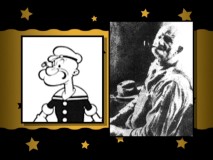 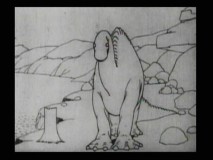 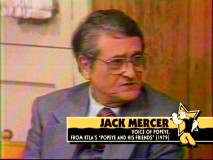
BONUS FEATURES, MENUS, and PACKAGING
Bonus features can be found on all four discs and they are easily divided into four types.
Most individually demanding of time are retrospective documentaries, of which there are two. Disc 1's "I Yam What I Yam: The Story of Popeye the Sailor" (43:20) is an excellent, thorough yet succinct biography of the character, covering his newspaper roots, animated career, and even touching upon Robert Altman's movie and more recent appearances. The center section on Popeye 'toons is understandably the most in-depth, as it discusses the voices, directors, musicians, and studios who made the sailor's film career what it was, looking at how the popular line progressed and changed hands over the years. A remarkable, encompassing roster of interview subjects make sure no facet is addressed without an expert's remark, be that expert an animation historian or someone involved with 1980's Popeye. Someone who enters this entirely ignorant of Popeye leaves with a comprehensive grasp on the hero and his many incarnations.
Disc 2's terrific 31-minute "Forging the Frame: The Roots of Animation 1900-1920" covers the films and filmmakers of animation's earliest chapter. Clips from the work of Winsor McCay, Bray Productions, and others are shown and analyzed by an impressive display of cartoon experts. Shedding light on both the DVD set's bonus shorts and Popeyes' animated predecessors, this great inclusion rewards but doesn't require some foreknowledge, and renders viewers informed and entertained.
Similar to the documentaries in design but a lot shorter are "Popeye Popumentaries", featurettes served at a rate of 2 per platter. Disc 1 provides "Mining the Strip: Elzie Segar and Thimble Theatre" (8:35), which tackles the sailor's comic strip origins and how he was changed for big screen animation, and "Me Fickle Goyl, Olive Oyl: The World's Least Likely Sex Symbol" (4:16), which offers modern-day opinions on the series' leading lady. On Disc 2, "Wimpy the Moocher: Ode to the Burgermeister" (4:30) explores the nature of Popeye's freeloading pal and "Sailor's Hornpipes: The Voices of Popeye" (9:28) analyzes and compares the work of Billy Costello, Jack Mercer, and other Popeye voice artists.
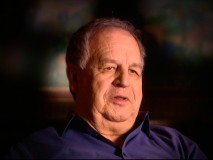  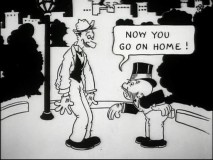
Disc 3's Popumentaries are "Blow Me Down! The Music of Popeye" (10:00), which pays tribute to the songs, melodies, and composers of the series (underscoring music's importance in animation at large), and "Popeye in Living Color: A Look at the Color Two-Reelers" (5:45), which lives up to its title by contextualizing the style change of the three longer late-'30s works and the reasoning behind it.
Disc 4 offers "Me Lil' Swee'Pea: Whose Kid is He Anyway?" (3:50), which covers the characteristics and unclear origins of the series' infant, and "Et Tu, Bluto? Cartoondom's Heaviest Heavy" (4:40), which discusses how Popeye's foe was greatly expanded from comics to cartoons and addresses his personality and name change.
Those who appreciate the audio commentary should be quite pleased to find twenty-two of the set's shorts accompanied by this. With no less than 15 different speakers behind them, the commentaries range widely in style and content, from the overly rehearsed to the candid. The speakers are a varied lot of animators and animation historians who consider themselves fans or inspired by the shorts. Some of the commentators seem unequipped to fill the air for even such brief runtimes, some are dryly scholarly, some are unabashedly in awe, and one (Jack Mercer) has been dead for over twenty years and is heard in archival audio clips. The topics discussed include the makers, the series' history, the characters, and the animation techniques. The tracks which identify who drew what and break down gags inevitably get a little dry, but these informative sessions should quench those with an endless thirst for animation history. Those looking for something a little different might appreciate the Mexican duo who appropriately talk over Blow Me Down! and the goofy trio who tackle most of the latter 'toons including both two-reelers.
Last but not least are sixteen cartoons from 1915 to 1933 designated as "From the Vault." As a whole, these shorts are arranged chronologically and also by studio while being divided among the four discs. Most of the first two discs' selections are forerunners to the work of the Fleischer Brothers. The rest mainly come from the Fleischers' mixed-medium, pre-Popeye "Out of the Inkwell" series. Only two contain any sound at all; Disc 2's Bobby Bumps has instrumental music, while the Popeye karaoke short on Disc 4 has fully-synchronized sound. In general, most of these predominantly comic-strip-spawned relics are unable to mask their age, with worn prints, odd pacing, dated sensibilities, silent soundtracks, and sometimes primitive motion. Still, there are charms to be discovered, especially among the eldest few.
On Disc 1, Pathe's Colonel Heeza Liar at the Bat (9:30, 1915) finds its diminutive title character driving to the stadium and aiding his favorite baseball team with curveballs and an un-Casey-like finale. Hearst-Vitagraph's Krazy Kat Goes A-Wooing (2:44, 1916) takes its monkeyish lead and his guitar to what he thinks is his "darlink" Ignatz's house. In Bud Fisher's Domestic Difficulties (8:15, 1916), a man named Mutt sneaks out of his apartment while his wife's away to be with another man (Jeff) for a night at the bar, with quite the consequences.
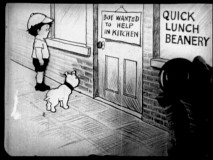 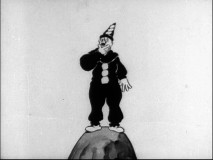 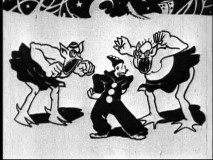
Disc 2's bonus shorts begin with Bray Studios' Bobby Bumps Puts A Beanery on the Bum (4:35, 1918), in which the titular boy and his dog Fido help out in a diner's kitchen. Pat Sullivan's Feline Follies (4:13, 1919) depicts the escapades of two cats in a town called Pussyville. Max Fleischer's The Tantalizing Fly (3:55, 1919) pits a cartoon clown against an animator-disturbing fly.
Disc 3 supplies six shorts from the Fleischer Brothers' "Out of the Inkwell" series: Modeling (7:58, 1921), Invisible Ink (7:30, 1921), Bubbles (4:47, 1922), Jumping Beans (10:50, 1922), Bed Time (8:53, 1923), and Trapped (10:56, 1923).
Historically significant but fairly tedious, each short finds an oft-rotoscoped clown (later named Koko) and occasionally his clones interacting with animator Max Fleischer in broad ways.
On Disc 4, we find the Fleischers' later, more ambitious Koko adventures. The clown rockets into outer space in Trip to Mars (6:46, 1924), works as a trainer of dogs and other animals in Koko Trains 'Em (10:05, 1925), and is part of a time inversion in Koko Back Tracks (9:03, 1927). Closing out the section is Let's Sing with Popeye (2:08, 1933), a very worn-looking novelty cartoon which follows up an excerpt from the sailor's cartoon debut with a bouncing ball (a Fleischer invention) that enables you to follow along with multiple verses of lyrics to his theme tune. This short short would play during the Saturday Matinee gatherings of the Popeye Club, a group lucrative to theaters that filled the mid-'30s void left by the dissolution of Disney-sponsored matinee Mickey Mouse Clubs.
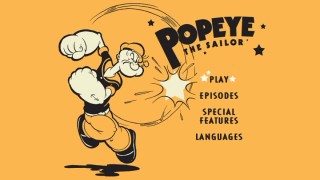 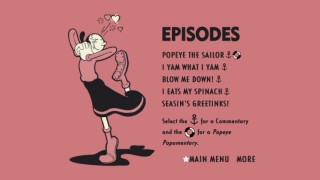
The disc's menus use the same type of understatement as the cover and disc art, with the main menu employing a primarily golden image of Popeye in action, while the sailor's instrumental theme plays. Though silent, submenus employ the same type of limited color artwork. One finds the six-sided Digipak, when unfolded, a double-sided insert offering a very minor coupon and recipes for two dishes that call, appropriately enough, for Popeye Spinach.
Disc Four opens with previews for upcoming animated Warner DVDs Looney Tunes: Golden Collection, Volume 5 and Superman: Doomsday. A Trailers section on the same disc serves up promos for "Wait Till Your Father Gets Home": The Complete First Season, "Space Ghost & Dino Boy"/"Birdman & Galaxy Trio"/Tex Avery's Droopy, "Smurfs": Season One, and Tom and Jerry Spotlight Collection, Volume 3.
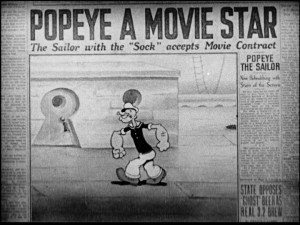 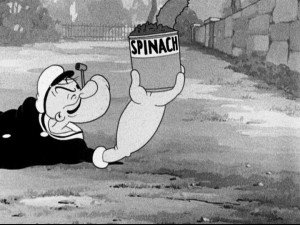
CLOSING THOUGHTS
While their historical and cultural value alone would merit mention, the sixty 1930s shorts of Popeye: Volume One more significantly manage to entertain, especially when enjoyed in moderation. Nearly three-quarters of a century since they were made, the Fleischers' Popeye cartoons offer fun in a broad universe that is easy to spend time in. Warner's four-disc DVD is a dream come true for fans of the Sailor Man, presenting his earliest animated adventures completely, chronologically and in their original forms. While picture quality leaves room for improvement, it's undoubtedly light years ahead of unofficial public domain releases and bound to be forgiven in consideration of the contents' age and origins. The set scores major points for an excellent offering of special features, serving up documentaries, featurettes, commentaries, and classic shorts that are sure to captivate and delight even choosy supplement viewers. In short, Warner's first Popeye collection earns a sturdy recommendation, not just for the animation buff and nostalgist, but for anyone able to enjoy cartoon shorts as old as, or more likely, quite a bit older than themselves.
More on the DVD / Buy from Amazon.com
|
